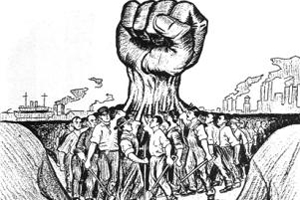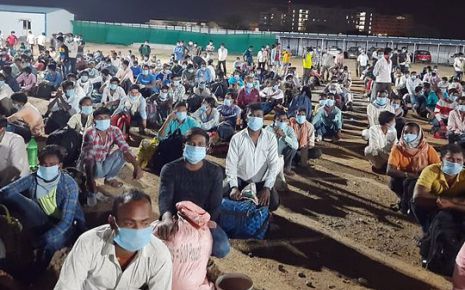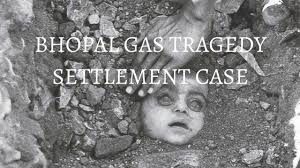Revolution in Labour Laws after Bhopal Gas Tragedy
The night of 3rd December 1934 in Bhopal, Madhya Pradesh around 12 am workers
working in the pesticide plant of Union Carbide India Limited noticed burning
sensation in their eyes, they realised that there might be a gas leak in the
premises. The workers then started investigating, then a worker came across a
dripping liquid along with it, a yellow-coloured gas was leaking, so he informed
the supervisor, after being informed he did not take any action.
After around 2 hours this gas is spread all over Bhopal carried by air resulting in one of the most disastrous accidents in the history of India which killed with an estimated death toll of approximately 2000-3000 people. This accident is also known as the Bhopal disaster. The Madhya Pradesh government compensated the families of the 574,366 wounded victims and the 3,787 people who died because of the gas spill in 2008.
According to a government declaration from 2006, the leak resulted in 558,125 injuries, 38,478 of which were temporary partial injuries and around 3,900 of which were seriously and permanently disabled people. Others claim that 8,000 people passed away within two weeks, and another 8,000 or more have subsequently passed away from illnesses linked to gas.
The owner was the factory, Union Carbide India Limited was owned in majority by the Union Carbide Corporation of the United States with Indian government-controlled banks and Indian Public holing a 49.1 % stake. This Union Carbide Indian Limited was built in the year 1969 to produce the pesticide Sevin using an intermediate that is Methyl Isocyanate (MIC.
This plant started producing MIC on their own in the year of 1979, as around this year the Union Carbide started facing losses and decided that instead of importing MIC, they would produce it in India. During this time, the company was asked to make an evacuation plan so in the case of dangerous gas leak the residents of Bhopal shall know how to react and how to evacuate but the company did not go through with the plan, even after death of an employee due to exposure to MIC in 1981.
Till date people suffer due to the aftermath of this chemical accidents which is stated to be the world's worst industrial disaster. Later changes were brought in the Factories Act,1948 to make laws for managing such hazardous industries, but Factories Act,1948 has not been so effective and still holds various loopholes.
Occupational Safety, Health, and Working Conditions Code, 2020 has been brought to elevate laws relating to various provisions which will apply to all the establishments and has more defined responsibilities of people associated with the industry. Main aim of this research paper is to understand those loopholes that were seen in the Bhopal Gas tragedy and find provisions to avoid such blunders through application of new legislations like Occupational Safety, Health, and Working Conditions Code, 2020.
Background
As the competition grew the company started taking various steps to reduce Manfacturing cost and production value:
Effects of the accident
Who was Responsible?
Aftermath
The disaster and the legal proceedings made the parliament realise that India did not have the right laws to hold people accountable like the definition of hazardous industry, occupier, and other provisions in the Factories Act 1948. And there were no other provisions which protected the workers in a hazardous industry and lack of protection of environment laws was also considered to one of the major drawbacks that lead to such disaster.
Changes that were brought to prevent such mishap:
The measure was approved by the president on September 28, 2020, but the official gazette has not yet announced when it will go into effect. In Occupational Safety, Health and Working Conditions Code, 2020 workers' health is protected, workplace machinery use is made safe, the physical environment of the workplace is improved, and welfare facilities are provided.
This code has repealed 13 labour laws:
Applicability of this code
This code applies to establishment which is defined under Section 2(v) of Occupational Safety, Health, and Working Conditions Code, 2020.
An establishment according to this code is:
Proviso;
Under sub clause (1) and (2) the threshold of workers shall be applied in case where the establishment in which such hazardous or life-threatening activity is being carried on, as may be notified by the central government.
And it shall not apply to the offices of the Central Government, offices of state government and any ship of war of any nationality;
Proviso:
Shall apply in case of contract labour employed through contract in the offices of the state government and central government.
As we saw in the case of Bhopal Gas Tragedy that the definition of Factory in the Factories Act,1948 covers a smaller number of people and also a lot of industries and establishments were excluded from the protection of labour laws in the Factories Act,1948 but this code aims to include all the establishment and help provide a proper safeguard for the all kinds of workers working in various industries.
It was defined under the Section 2(w) of the Occupational Safety, Health, and Working Conditions Code, 2020 which meant any premises including precincts where:
Definition of Hazardous according to Occupational Safety, Health, and Working Conditions Code, 2020
Section 2(z) of this code defines hazardous as an activity involving danger or potential danger.
Section 2 (za)- Hazardous process under Schedule I there 40 kinds of industries involved, and the appropriate government can add any industry if it thinks deem to be fit.
After the case of Bhopal Gas tragedy, the definition of Occupier was added in the Factories Act,1948 but responsibilities and duties of an occupier are not stated in detail. But Occupational Safety, Health, and Working Conditions Code, 2020 lays down proper provisions relating to the responsibilities of an occupier. Defining Occupier and providing
These provisions require the Occupier to:
Chapter III of the Occupational Safety, Health, and Working Conditions Code, 2020 includes the duties of the Employer and Employee
Duties of employer are given under the provisions of Section 6 to Section 9:
The following responsibilities must be met:
Conclusion
Bhopal gas tragedy helped us realise that our legal system had various loopholes that were needed to be eliminated and changes in the existing legislations was important. Over the years we have noticed that various provisions do not include all the workers which leads to manipulation so the new code i.e., Occupational Safety, Health, and Working Conditions Code, 2020 includes all the establishment and provide provisions relating to betterment of working conditions, amenities, and facilities for the workers that we are working in an establishment.
Occupational Safety, Health, and Working Conditions Code, 2020 has been assented and is expected to be applied repealing around 13 laws which would provide a better situation for the workers and will provide a designation of workers in an establishment so if an accident happens then it will be easy to define the person liable for such incident.
The Code creates national and state occupational safety boards to advise the Central and State Governments on the standards, rules, and regulations that will be formulated in accordance with the Code. The board is made up of a variety of professionals from both the Central and State governments.
Bibliography:
Written By:
After around 2 hours this gas is spread all over Bhopal carried by air resulting in one of the most disastrous accidents in the history of India which killed with an estimated death toll of approximately 2000-3000 people. This accident is also known as the Bhopal disaster. The Madhya Pradesh government compensated the families of the 574,366 wounded victims and the 3,787 people who died because of the gas spill in 2008.
According to a government declaration from 2006, the leak resulted in 558,125 injuries, 38,478 of which were temporary partial injuries and around 3,900 of which were seriously and permanently disabled people. Others claim that 8,000 people passed away within two weeks, and another 8,000 or more have subsequently passed away from illnesses linked to gas.
The owner was the factory, Union Carbide India Limited was owned in majority by the Union Carbide Corporation of the United States with Indian government-controlled banks and Indian Public holing a 49.1 % stake. This Union Carbide Indian Limited was built in the year 1969 to produce the pesticide Sevin using an intermediate that is Methyl Isocyanate (MIC.
This plant started producing MIC on their own in the year of 1979, as around this year the Union Carbide started facing losses and decided that instead of importing MIC, they would produce it in India. During this time, the company was asked to make an evacuation plan so in the case of dangerous gas leak the residents of Bhopal shall know how to react and how to evacuate but the company did not go through with the plan, even after death of an employee due to exposure to MIC in 1981.
Till date people suffer due to the aftermath of this chemical accidents which is stated to be the world's worst industrial disaster. Later changes were brought in the Factories Act,1948 to make laws for managing such hazardous industries, but Factories Act,1948 has not been so effective and still holds various loopholes.
Occupational Safety, Health, and Working Conditions Code, 2020 has been brought to elevate laws relating to various provisions which will apply to all the establishments and has more defined responsibilities of people associated with the industry. Main aim of this research paper is to understand those loopholes that were seen in the Bhopal Gas tragedy and find provisions to avoid such blunders through application of new legislations like Occupational Safety, Health, and Working Conditions Code, 2020.
Background
Union Carbide MIC Plant
The location of the Plant was questioned by the commissioner and director of Bhopal and several other authorities. The plant was situated in the outskirts of Bhopal around 3 kms away from two major hospitals and about a km away from the railway station, despite the rules and regulation specifically laid down for an insecticide and pesticide company to build a factory, which is that it should be 25 kms away from the nearest city.Toxicity of MIC
In case of Bhopal disaster, the MIC was used as an intermediate to make Sevin and when it reacts with water it produced the most dangerous gas which if ingested or inhaled can cause severe harmful diseases and if encountered in sizeable proportion can cause death. Having a boiling point of 39.1-degree Celius, MIC vaporises at room temperature and exists as odourless and colourless gas. Contact with this gas can cause irritation in eyes and throat or cough.Causes for the Accident:
- The lethal MIC gas leaked from one of the factory's tanks around midnight because of the chemical reaction that started at the Union Carbide (India) Limited facility.
- On December 3, 1984, around 45 tonnes of the poisonous chemical MIC leaked from an insecticide factory run by the Indian affiliate of the American company Union Carbide Corporation.
- The disaster happened when water got into a tank holding MIC. This set off a chain of events that led to the accumulation of a significant amount of carbon dioxide among other things.
- The ensuing reaction caused the temperature within the tank to rise to above 200 °C (392 °F).
- The pressure of two of the three tanks was inadequate.
- The indicator showing the level of MIC was not working.
- There was an alarm which wound alert people if the temperature increases in any of the tanks but few years before the accident it was turned off due to some issue and was even fixed.
As the competition grew the company started taking various steps to reduce Manfacturing cost and production value:
- Company did cost cutting as the competition grew.
- Workforce was reduced as the company was facing several losses.
- Company employed unqualified workers as we know that in a hazardous industry workers shall be employed after being trained and educated about the substances; they are working with which is hazardous in nature.
- The leak was ignored by the workers and the supervisor, if necessary, measures were taken before then this accident would have been stopped.
Effects of the accident
- The following day after the accident Union Carbide sent their technical team to India and the team converted the remaining MIC into a less dangerous gas. "Operation Faith" was carried out on 16th of December 1984 wherein the E611 and E619 tanks were emptied out of the remaining MIC.
- Union Carbide was questioned which resulted to them giving money as a relief for the victims of the Bhopal gas leak.
- They gave millions of dollars to the Government, the Red Cross and several other relief organisations and Warren Anderson the Chairperson of the Union Carbide at the time was arrested
- The next year, in 1985 an act was passed in parliament which empowers the Government of India to represent the people of Bhopal in court and hold investigations to know that how such deadly accident happened.
Who was Responsible?
- Union Carbide Corporation V. Union of India 1990 AIR 273, 1989 SCC (2) 540
- A suit was filed against the corporation and the chairperson of Union Carbide at the time Warren Anderson is arrested. The government of India and Union Carbide began their investigations.
- Both investigations agree that the main cause of the accident was when water was mixed with MIC which resulted in a production of a poisonous gas which clouded the city of Bhopal.
- Indian government claimed that the Union Carbide was at fault because of which water leaked into the tanks.
- Union Carbide argued that the Indian Government was at fault there as the government did not allow them to make changes in the safety design of the company and said that it was the fault of the workers at the plant rather than the company and they also claimed that the workers had sabotaged the plant.
- Later Union Carbide decided for a settlement and decided to pay 470 million dollars in compensation to thousands of victims of the December 1984 Bhopal gas leak disaster.
- Unions Carbide and Warren Anderson were declared to be Criminals by the court.
Aftermath
The disaster and the legal proceedings made the parliament realise that India did not have the right laws to hold people accountable like the definition of hazardous industry, occupier, and other provisions in the Factories Act 1948. And there were no other provisions which protected the workers in a hazardous industry and lack of protection of environment laws was also considered to one of the major drawbacks that lead to such disaster.
Changes that were brought to prevent such mishap:
- Environment Protection Act was brought in 1986 which ensures that the industries shall take steps and initiatives to protect the environment.
- Factories Act 1948:
- New Chapter was added in the Factories Act 1948 after the Bhopal gas Tragedy relating to the scope that only covered the workers which then extended to the public and people around the premises.
- The changes also provided for amount of hazardous material that could be kept in the premises.
- The definition of occupier was made to be one of the most important effects of this case as in the Bhopal gas tragedy it was difficult to put a figure on who was responsible for the accident. So, the definition of occupier would help to understand who oversees the vicinity where hazardous activities were taking place.
- The punishment related provisions were also changed if a person did not comply with the hazardous process relating provisions under Chapter IV A.
- Several laws were made to support the victims of industrial disasters.
The measure was approved by the president on September 28, 2020, but the official gazette has not yet announced when it will go into effect. In Occupational Safety, Health and Working Conditions Code, 2020 workers' health is protected, workplace machinery use is made safe, the physical environment of the workplace is improved, and welfare facilities are provided.
Occupational Safety, Health, and Working Conditions Code, 2020
Occupational Safety, Health, and Working Conditions Code, 2020 seeks to consolidate and modify the laws regulating the occupational safety. Health and working conditions.This code has repealed 13 labour laws:
- The Factories Act,1948
- The Plantation Labour Act,1951
- The Mines Act, 1952
- The Working Journalists and other Newspaper Employees (conditions of service) and Miscellaneous
- The Working Journalists (fixation of rates of wages) Act, 1958
- The Motor Transport Workers Act,1961
- The Beedi and Cigar Workers (conditions of employment) Act, 1966
- The Contract Labour (regulation and abolition) Act, 1970
- The Sales Promotion Employees (conditions of service) Act, 1976
- The Inter-State Migrant Worker (regulation of employment and conditions of service) Act,1979
- The Cine-Workers and Cinema Theatre Workers (regulation of employment) Act, 1981
- The Dock Workers (safety, health, and welfare) Act,1986
- The building and other Construction Workers 9regulations of employment and conditions of service) Act,1996
Applicability of this code
This code applies to establishment which is defined under Section 2(v) of Occupational Safety, Health, and Working Conditions Code, 2020.
An establishment according to this code is:
- Anyplace where any industry, trade, business, manufacturing, or occupation is carried out in which 10 or more workers are employed; or
- Motor transport undertaking, newspaper establishment, audio-video production, building and other construction work or plantation in which 10 or more workers are employed; or
- Factory for the purpose of Chapter II in which 10 or more workers are employed, notwithstanding the threshold of workers provided in clause (w); or
- A mine or port or vicinity of port where dock work is carried out.
Proviso;
Under sub clause (1) and (2) the threshold of workers shall be applied in case where the establishment in which such hazardous or life-threatening activity is being carried on, as may be notified by the central government.
And it shall not apply to the offices of the Central Government, offices of state government and any ship of war of any nationality;
Proviso:
Shall apply in case of contract labour employed through contract in the offices of the state government and central government.
As we saw in the case of Bhopal Gas Tragedy that the definition of Factory in the Factories Act,1948 covers a smaller number of people and also a lot of industries and establishments were excluded from the protection of labour laws in the Factories Act,1948 but this code aims to include all the establishment and help provide a proper safeguard for the all kinds of workers working in various industries.
Definition of Factory as per Factories Act, 1948
It was defined under the Section 2(m) of the Factories Act, 1948 which meant any premises including precincts where:- 10 or more workers are working any day of the preceding 12 months. For carrying manufacturing process without the aid of power.
- 20 or more workers are working on any day of the preceding 12 months for carrying manufacturing process with the aid of power.
- It did not include mines, mobile units belonging to the armed forces of the
Union, railway running shed, hotel, restaurant or eating place.
It was defined under the Section 2(w) of the Occupational Safety, Health, and Working Conditions Code, 2020 which meant any premises including precincts where:
- 20 or more workers are working any day of the preceding 12 months. For carrying manufacturing process without the aid of power.
- 40 or more workers are working on any day of the preceding 12 months for carrying manufacturing process with the aid of power.
- It did not include mines, mobile units belonging to the armed forces of the Union, railway running shed, hotel, restaurant or eating place.
Definition of Hazardous according to Occupational Safety, Health, and Working Conditions Code, 2020
Section 2(z) of this code defines hazardous as an activity involving danger or potential danger.
Section 2 (za)- Hazardous process under Schedule I there 40 kinds of industries involved, and the appropriate government can add any industry if it thinks deem to be fit.
After the case of Bhopal Gas tragedy, the definition of Occupier was added in the Factories Act,1948 but responsibilities and duties of an occupier are not stated in detail. But Occupational Safety, Health, and Working Conditions Code, 2020 lays down proper provisions relating to the responsibilities of an occupier. Defining Occupier and providing
Responsibilities of Occupier
Any occupier's responsibilities are outlined in Sections 84 and Section 85.These provisions require the Occupier to:
- As required by the State Government, workers, local authorities under the factory's jurisdiction, the Chief Inspector-cum-facilitator or Inspector-cum-facilitator, and the public shall be informed of all risks, health hazards, measures, handling, manufacturing, transportation, and storage processes of such hazardous materials.
- Must have an on-site contingency strategy.
- Disclose the waste's properties (for example, the amount of MIC in the Bhopal Gas Tragedy was too high).
- He or she must keep up-to-date, accurate health records that are available to the employees.
- Appoint or recruit individuals with the necessary training to handle hazardous products, and he must educate the candidate.
- The punishment for non-compliance and if any worker dies due to handling the hazardous material occupier will be liable, imprisonment can up to 2 years and fine up to 5 years.
Duties of Employer:
This code also includes duties of Employer and Employee in a Hazardous Industries. In Factories Act,1948 such duties were not in depth. Defining the responsibilities of such all the people associated to the industry is important as it will help reducing consequences of such big accidents like oleum gas leak or Bhopal gas leak.Chapter III of the Occupational Safety, Health, and Working Conditions Code, 2020 includes the duties of the Employer and Employee
Duties of employer are given under the provisions of Section 6 to Section 9:
The following responsibilities must be met:
- Providing a workplace free from hazards that could result in ailments or injuries;
- Offering free annual health examinations to employees in establishments that have been notified;
- Sending appointment letters to employees; and
- Notifying the appropriate authorities if an accident at work results in the death or serious bodily injury of an employee. Employers are required to do additional tasks in factories, mines, ports, plantations, and buildings and construction work, such as providing a risk-free work environment and educating staff members on safety procedures.
Duties of Employee:
- Duties of employee are given under the provisions of Section 13:
- Among their responsibilities include maintaining their personal health and safety, abiding by safety and health regulations
- Comply with the safety and health requirements specified in the standards.
- Corporate with the employer to help meet the statutory obligations
- Not interfere wilfully with or misuse any appliance, convenience or other thing provided for the purpose of securing the health, safety, and welfare of workers
- Not do, wilfully and without reasonable cause, anything, likely to endanger himself
- Perform such other duties as may be prescribed by the appropriate government.
- Reporting dangerous work-related situations to the Inspector.
- The right to ask their employer for information on safety and health requirements is one of the rights that employees also enjoy.
Conclusion
Bhopal gas tragedy helped us realise that our legal system had various loopholes that were needed to be eliminated and changes in the existing legislations was important. Over the years we have noticed that various provisions do not include all the workers which leads to manipulation so the new code i.e., Occupational Safety, Health, and Working Conditions Code, 2020 includes all the establishment and provide provisions relating to betterment of working conditions, amenities, and facilities for the workers that we are working in an establishment.
Occupational Safety, Health, and Working Conditions Code, 2020 has been assented and is expected to be applied repealing around 13 laws which would provide a better situation for the workers and will provide a designation of workers in an establishment so if an accident happens then it will be easy to define the person liable for such incident.
The Code creates national and state occupational safety boards to advise the Central and State Governments on the standards, rules, and regulations that will be formulated in accordance with the Code. The board is made up of a variety of professionals from both the Central and State governments.
Bibliography:
- Factories Act, 1948
- Occupational Safety, Health, and Working Conditions Code, 2020
- Union Carbide Corporation V. Union of India 1990 AIR 273, 1989 SCC (2) 540
- https://www.bhopal.com/
- https://prsindia.org/billtrack/the-occupational-safety-health-and-working-conditions-code-2019
Written By:
- Aarushi Yadav
- Bhavesh Singhvi
Law Article in India
Legal Question & Answers
Lawyers in India - Search By City
LawArticles
How To File For Mutual Divorce In Delhi

How To File For Mutual Divorce In Delhi Mutual Consent Divorce is the Simplest Way to Obtain a D...
Increased Age For Girls Marriage

It is hoped that the Prohibition of Child Marriage (Amendment) Bill, 2021, which intends to inc...
Facade of Social Media

One may very easily get absorbed in the lives of others as one scrolls through a Facebook news ...
Section 482 CrPc - Quashing Of FIR: Guid...

The Inherent power under Section 482 in The Code Of Criminal Procedure, 1973 (37th Chapter of t...
The Uniform Civil Code (UCC) in India: A...

The Uniform Civil Code (UCC) is a concept that proposes the unification of personal laws across...
Role Of Artificial Intelligence In Legal...

Artificial intelligence (AI) is revolutionizing various sectors of the economy, and the legal i...








Please Drop Your Comments